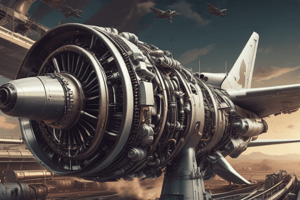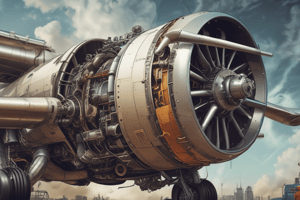Podcast
Questions and Answers
What does the designation GTSIO-520 indicate about an engine?
What does the designation GTSIO-520 indicate about an engine?
- It is a turbocharged engine with a displacement of 520 cm3.
- It is a naturally aspirated engine with a displacement of 520 in3.
- It is a supercharged, injected, opposed engine of 520 in3 displacement. (correct)
- It is a diesel engine with a displacement of 520 horsepower.
Which method is primarily involved in heat transfer to air from cooling fins?
Which method is primarily involved in heat transfer to air from cooling fins?
- Induction
- Convection (correct)
- Condensation
- Radiation
In which arrangement are the cylinders of an in-line engine typically positioned?
In which arrangement are the cylinders of an in-line engine typically positioned?
- In the shape of a letter V.
- In two rows perpendicular to the crankshaft.
- In a single row parallel to the crankshaft. (correct)
- In a circular pattern.
Who is credited with contribution that led to the evolution of the first practical turbojet engine in England and the United States?
Who is credited with contribution that led to the evolution of the first practical turbojet engine in England and the United States?
What characterizes a single-row radial engine?
What characterizes a single-row radial engine?
Flashcards
In-line engine
In-line engine
A type of engine with cylinders arranged in a single row parallel to the crankshaft.
Conduction
Conduction
Heat transfer through direct contact between objects of different temperatures.
Convection
Convection
Heat transfer by the movement of fluids (liquids or gases).
Radial engine
Radial engine
Signup and view all the flashcards
Whittle Turbojet Engine
Whittle Turbojet Engine
Signup and view all the flashcards
Study Notes
Engine Types and Characteristics
- GTSIO-520: Indicates a geared, turbosupercharged, injected, opposed engine of 520 in³ displacement.
Heat Transfer Mechanisms
- Heat transfer from cooling fins to air occurs via conduction.
Engine Cylinder Arrangements
- An in-line engine has cylinders arranged in a "V" shape.
- Cylinders can be arranged in a single row parallel to the crankshaft.
- Cylinders can be arranged in two rows perpendicular to the crank-shaft.
- Cylinders can be arranged in a circular pattern.
Radial Engines
- A single-row radial engine has an odd number of cylinders extending radially from the crankshaft's center.
Turbojet Engine Development
- The first practical turbojet engine was developed in England and the US, stemming from breakthroughs by various individuals, including the Wright brothers, George B. Brayton, Gottlieb Daimler, and Frank Whittle.
Studying That Suits You
Use AI to generate personalized quizzes and flashcards to suit your learning preferences.



